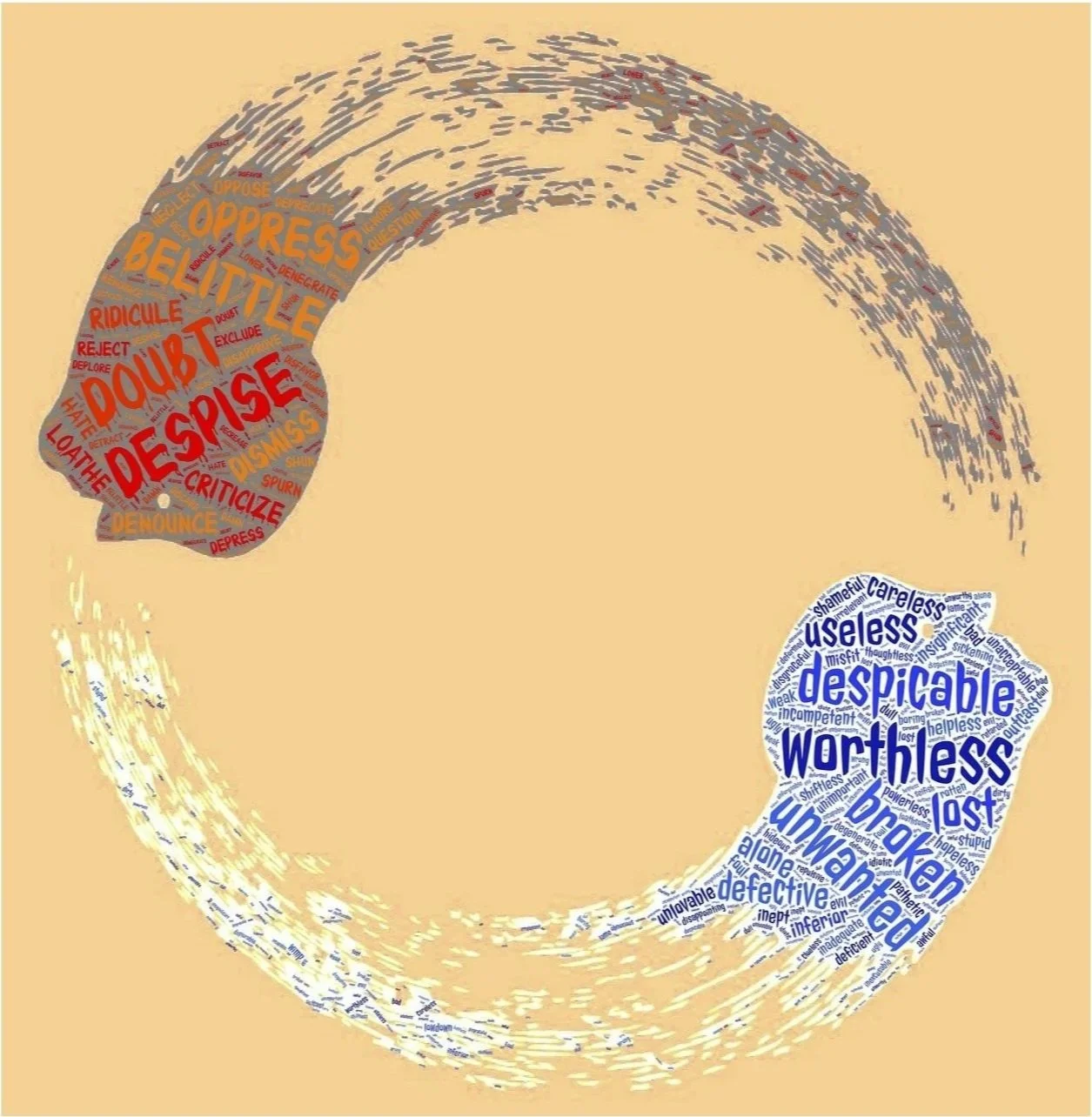Unblending from Your Inner critic: How to Heal Chronic Shame USING IFS
Most of us carry a voice inside that tells us we’re not good enough. That we should have done more. That we’re lazy, selfish, fake, unworthy. This voice is relentless, harsh, and often sounds like an internalized authority figure. It’s what many of us know as the inner critic — a part of the psyche that takes on the role of constant evaluator, judge, and punisher.
Learning to unblend from your inner critic is the first crucial step in healing from chronic shame. Until we do, it runs the show from the inside, hijacking our emotions, dimming our self-worth, and driving patterns of self-sabotage, perfectionism, or avoidance. But once we begin to recognize it for what it is—a protective part, not our essential self—we create the space for compassion, healing, and true transformation.
This post is Step 1 in a four-part series on overcoming chronic shame using Internal Family Systems (IFS) therapy. In this step, we’ll explore how to unblend from your inner critic—the essential first move toward self-compassion and inner safety.
(To move through this series in order, see the links at the end of this post.)
What Is the Inner Critic?
According to Internal Family Systems therapy (IFS), the inner critic is a subpersonality, or "part," that takes on the role of monitoring and controlling our behavior. It often uses fear, blame, or shame to push us toward perfection, safety, or acceptance. For most people, the inner critic manifests as an internal monologue - an inner voice that speaks to us more harshly than we would likely ever speak to someone else.
One way to notice your critic is in how it talks to you. This part tends to speak in absolutes:
“You’ll never be good enough.”
“You’re so stupid—why did you say that?”
“Everyone will leave you if they see the real you.”
“You should have known better.”
“Stop making excuses for yourself!”
It may sound cruel, but its intentions are rarely malicious. It developed to protect us. Somewhere along the way, we learned that criticism, self-monitoring, and suppression were necessary for survival. And so a part of us took on the job.
How the Inner Critic Forms
Our inner critic usually forms in childhood, often as a response to:
Harsh parenting, criticism, or punishment
Emotional neglect or conditional love
Peer rejection, bullying, or exclusion
Cultural or religious environments that promote shame or rigid ideals
Repeated experiences of being shamed or misunderstood
If we were frequently shamed or punished for expressing our needs, emotions, or making mistakes, we learned to preemptively criticize ourselves before others could. It was safer to beat ourselves to the punch than to risk being humiliated or rejected. Over time, this pattern becomes automatic, internalized, and woven into how we see ourselves. Research from the Trauma Research Foundation highlights how these early attachment injuries shape self-perception and internal dialogue later in life.
The inner critic is usually trying to help us avoid pain—pain we once couldn’t stop from happening.
The Link Between the Inner Critic and Chronic Shame
Chronic shame stems from the deeply ingrained belief that we are fundamentally flawed, broken, or unlovable. It is not the same as guilt, which is about what we’ve done. Shame is about who we are. And nothing reinforces shame more effectively than a powerful inner critic.
When the critic is “blended” with our sense of self, we begin to believe its messages. We don’t hear it as “a voice,” we hear it as truth. We identify with it completely.
This is why unblending from the inner critic is essential. When we unblend, we begin to relate to the critic instead of being ruled by it. That distinction is subtle but revolutionary.
What Is Unblending?
Unblending is the process of separating your core Self—the part of you that is compassionate, curious, calm—from a part that has temporarily taken over. It’s a concept drawn from Internal Family Systems (IFS), a therapeutic model that views the mind as made up of distinct subpersonalities, or “parts.”
When you’re blended with a part, like the inner critic, you are it. You feel what it feels. You speak from it. You see the world through its eyes. But when you unblend, you take a step back. You begin to observe the part instead of merging with it.
Think of it like being an actor on stage. When you’re blended with the critic, you’re fully in character—living the role. When you unblend, you step offstage and watch the scene from the wings. You can now respond with compassion and perspective.
How to Know You’re Blended with the Inner Critic
You’re likely blended when:
Your self-talk is harsh, absolute, and shame-based
You feel small, defective, or hopeless
You’re constantly trying to prove your worth through performance
You avoid vulnerability or risk out of fear of exposure
You can’t access compassion or curiosity toward yourself
In these moments, it’s easy to forget that a part of you is operating in distress. You may just feel broken. But that’s exactly the illusion the critic creates.
Unblending in Practice: Step-by-Step
Unblending is a practice. Like any skill, it strengthens with repetition. Here’s a basic process to begin working with your inner critic somatically and compassionately:
1. Notice the Voice
Slow down and tune in. When you hear harsh self-talk or feel sudden shame, pause. Ask yourself: What am I saying to myself right now?
Try to hear it as a voice—a part, not the whole of you.
You may find that the critic has a particular way of talking that is different from how you talk to yourself when you’re not feeling ashamed. It may be:
harsher than usual - refusing to accept anything you can say in your defense
absolute - you are either good or bad, there is no in-between
in the voice of an overly critical caregiver (e.g. if your parent always said you were “lazy” it might use that criticism a lot)
The more quickly you can identify when the critic is speaking, the more easily you can separate yourself from this part.
2. Name the Part
Give this part an identity. You might call it “the Judge,” “the Perfectionist,” “the Taskmaster,” or simply “the Critic.” Naming helps create distance.
Say internally or aloud: “[the Critic] is criticizing me right now.”
It may also help to give this part an avatar - an image in your head that you associate with the character. It may be the image of a harsh disciplinarian or the face of an overly critical parent.
Put the voice to the image - you are not speaking to yourself this way, the Critic is speaking this way to you.
3. Locate It in the Body (if you can)
Ask yourself: Where do I feel this part? Is it a tightening in the chest? A heat in the face? A hollowness in the belly?
Often the inner critic does not have a clear bodily sensation right away - it mostly shows up as a voice. Nevertheless, whenever you hear the critic, see if you can find them in your body. Engaging with somatic therapy can help connect your physical sensations with emotional patterns, making healing more accessible.
This helps ground the experience somatically and makes it more accessible for healing.
4. don’t argue, Get Curious
Intuitively, many of us will want to take an oppositional stance to the critic and attempt to defend ourselves. We will increasingly hate it and want to push it away. This is a trap - the critic wants you to argue with it and (in most cases) it will win the argument because that is it’s job.
Instead of arguing with the critic, it’s much more effective to get curious. Ask:
What are you afraid would happen if you didn’t criticize me?
How long have you been doing this job?
Do you want to be doing this job? Are you tired of this?
What do you want for me?
You might be surprised at the answers. Often the critic is terrified that without its control, you’ll be rejected, fail, or hurt again.
Additionally, you are likely to find that the critic wants for you all the same things you want for yourself - it wants you to succeed, to be safe, to be loved. The critic is just stuck using harsh self-criticism as the only means of getting those things. It doesn’t know (or believe in) a different approach.
5. Unblend
Now say to yourself: “This is just a part of me. I am not this voice.”
You might imagine stepping back from it, or placing it beside you in a chair.
It may also help to change the voice of the Critic to something less threatening - like Homer Simpson’s or Micky Mouse’s voice. Do the same thing with the image - change it from an adult disciplinarian to a teenager in an ill-fitting suit. The Critic takes itself so seriously despite being a young and immature part. You don’t need to go along with this illusion.
Feel the difference between the part and your core Self—the one who can listen, care, and lead.
6. Offer Compassion
From this unblended place, offer the part gratitude for trying to protect you—even if its strategy is outdated. Try to remember that this part has stemmed from real wounding you’ve endured.
You can say:
“Thank you for trying to help.”
“You don’t have to work so hard right now.”
“I’m here now. I’ve got this.”
Over time, this builds trust between your Self and your parts—and gradually allows the critic to soften.
Why This Is So Hard (and So Important)
Unblending isn’t always easy. The critic can be relentless, persuasive, and deeply entwined with our identity. Many of us have spent years living inside its narrative. Unblending may feel unfamiliar, even unsafe at first. That’s okay.
But it’s the first step toward healing chronic shame. As long as we are blended with the inner critic, there’s no space for self-compassion. And without compassion, healing can’t take root.
When we begin to witness the critic instead of obey it, something remarkable happens: we stop believing every cruel thing we think about ourselves. We begin to see the difference between what we were told and who we truly are. That’s when shame begins to dissolve.
Final Thoughts: You Are Not Your Inner Critic
The inner critic may be loud, but it is not the truth of who you are. It’s a part —a younger, frightened, protective part— that once thought criticism was the only way to keep you safe. And it worked, to some degree. You survived.
But you are not a child anymore. You are allowed to be kind to yourself. You are allowed to make mistakes, to rest, to feel. You are allowed to lead your life from compassion, not criticism.
Unblending from your inner critic is not a one-time fix. It’s a practice of returning—again and again—to your wiser, softer, more grounded self. The part of you that knows: you are already enough.
And you always have been.
Continue the Series
This post is Step 1 in a 4-part series on overcoming chronic shame using IFS therapy:
You are here: Unblending from Your Inner Critic
Ready to Heal Shame at the Root?
If you’re struggling with low self-confidence, chronic shame or self-criticism, I have a customized approach that can help you reconnect with the parts of yourself that long for compassion and belonging.
Learn more about my approach to Therapy for Shame here.
Learn more about Internal Family Systems (IFS) therapy here.


